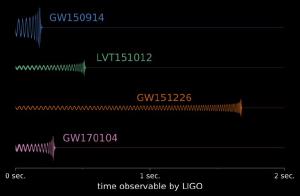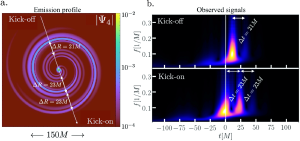Blog
The Last Word
12 October 2020
Gravitational waves are produced by all moving masses, from the Earth’s wobble around the Sun to your motion as you go about your daily life. But at the moment, those gravitational waves are too small to be observed. Gravitational observatories such as LIGO and VIRGO can only see the strong gravitational waves produced by merging stellar-mass black holes.
 LIGO/Caltech/MIT/University of Chicago (Ben Farr)
LIGO/Caltech/MIT/University of Chicago (Ben Farr)The gravitational signal of merging black holes is very distinct. A periodic wave rises in amplitude as the two black holes spiral ever closer, which ends in a “chirp” as the black holes merge. This signal’s size and length tell us about the size of both the initial black holes and the final one. But new computer simulations find nuances to the signal that could tell us even more about these mergers.1
In this new work, the team simulated what are known as asymmetrical mergers. These are merging binaries where the mass of one black hole is much larger than the other. They are particularly interesting to astronomers because the gravitational waves they emit can reveal more details than mergers of similar mass black holes. Since the gravitational waves emitted by asymmetrical mergers are also asymmetric, the resulting merged black hole can get a gravitational kick, which sends it away from its original location. This could be why a few galaxies such as the Triangulum Galaxy don’t have a supermassive black hole.
 Calderon Bustillo, et al
Calderon Bustillo, et alWhen the team looked at simulated mergers with a gravitational kick, they found gravitational wave signals with multiple chirps. The merger itself causes the primary chirp, but the asymmetric kick produces secondary chirps. The size and timing of these chirps depend on the direction of the kick and dynamics of the event horizon of the merged black hole as it settles into a stable shape.
Current gravitational observatories might be able to detect a secondary chirp in a highly asymmetrical merger, but they wouldn’t be able to see much detail. Planned observatories such as the space-based LISA program could, however. With enough sensitivity, we could even test one of the fundamental ideas about black holes known as the no-hair theorem. The theorem states that the event horizon of a stable black hole should have no surface details (or hair) that could reveal its history. In other words, the shape of an event horizon depends only on the mass, rotation, and electric charge of a black hole. General relativity predicts that the no-hair theorem is true, but some alternatives to GR predict otherwise.
We are still in the early stages of gravitational wave astronomy. Work such as this shows that we still have a great deal to learn about this exciting new field.
Calderon Bustillo, et al. “Post-merger chirps from binary black holes as probes of the final black-hole horizon.” Communication Physics 3, 176 (2020). ↩︎